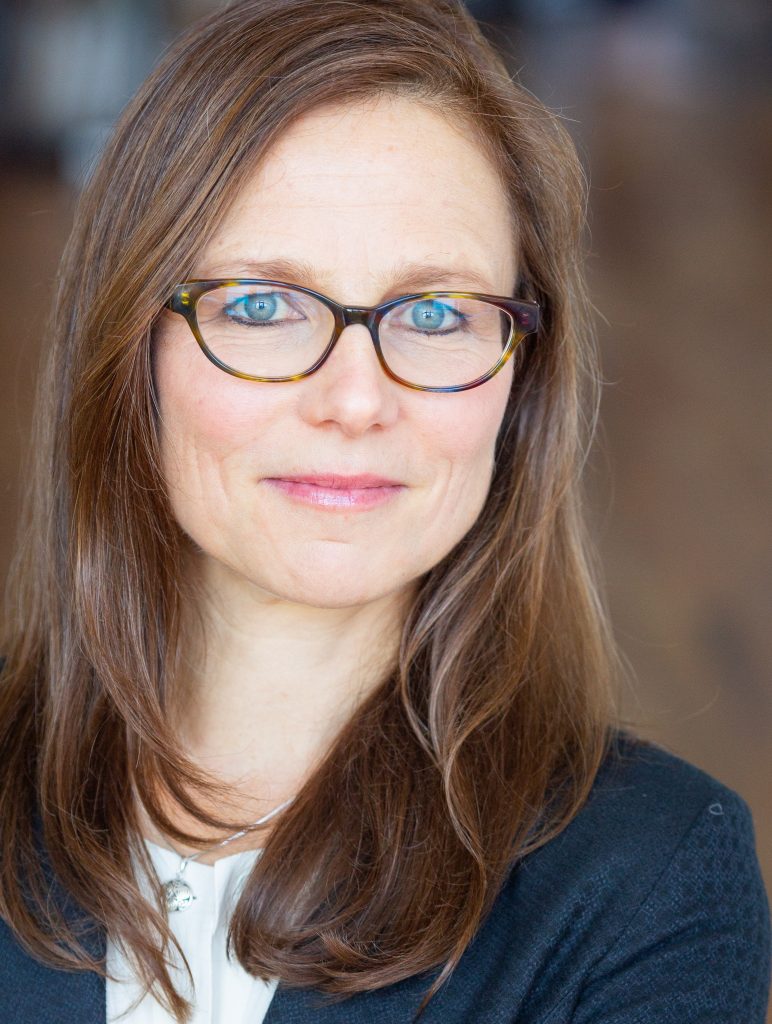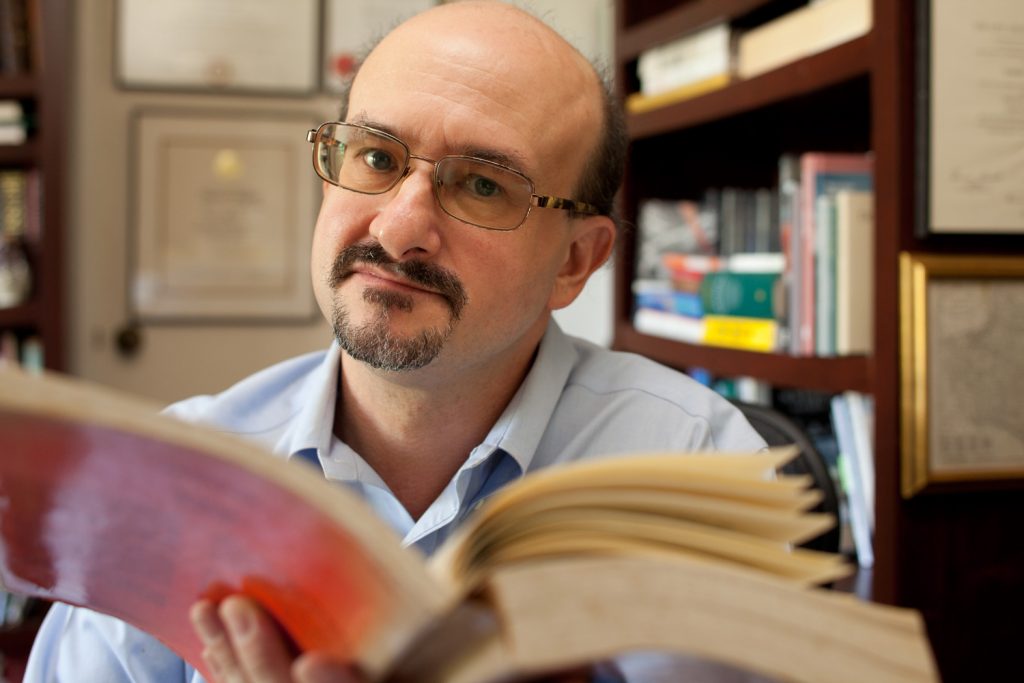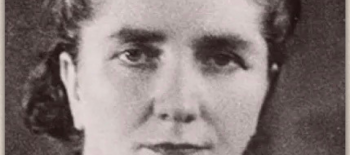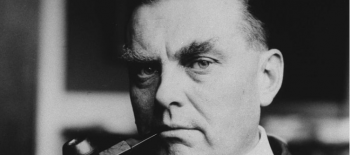June 1, 2021
Episode 5 and video recordings will be available at:
Polish Cultural Institute New York YouTube
Encounters with Polish Literature is a new video series for anyone interested in literature and the culture of books and reading. Each month, host David A. Goldfarb will present a new topic in conversation with an expert on that author or book or movement in Polish literature. More about the Encounters with Polish Literature series and the timeline.
Bruno Schulz (1892-1942) created a rich symbolic world in his small body of literary work and in his graphic art that left a huge legacy in Polish literature and in Jewish literature outside Poland. His stories contained mainly in two collections, Cinnamon Shops (1934) and The Hourglass Sanatorium (1938), along with a few other stories published separately, critical works, and letters, are a testament to the fecund cultural environment of the East European region of Galicia between the wars. Schulz is a secular Jewish writer whose stories, which we know from the recent discovery of an early work entitled, “Undula” (1922) seem to come out of the themes in his artwork, but were forged into their mature form as letters to the Yiddish modernist poet Debora Vogel. He wrote them in Polish, was celebrated in Polish avantgarde circles, and the most extensive body of Schulz scholarship is in Polish. His work reflects the influence of German writer Thomas Mann, as well as Franz Kafka and Leopold von Sacher-Masoch (author of Venus in Furs), who were German-language writers of non-German cities of the Austro-Hungarian empire like Schulz–Prague and Lemberg (Lviv) respectively. Postwar Jewish writers in a variety of languages such as Philip Roth, Cynthia Ozick, Danilo Kiš, David Grossman, Jonathan Safran Foer, and Nicole Krauss, have created characters on the model of Schulz’s biography. In the confluence of cultures brought about by modernization and aggressive industrial forces in the Drohobycz-Borysław oil producing region, Schulz’s idea of the writer sifting through the trash–tandeta–to find and reassemble mutilated fragments of cast-off mythologies or systems of meaning would become a model for generations of writers following the upheaval of the Second World War, post-Communism, and even post-Colonialism.
In this episode of “Encounters with Polish Literature,” we are focusing on Karen Underhill’s research into Schulz in the Jewish modernist context of his own day, rather than his post-Holocaust legacy among the international community of Jewish writers, or strictly in the Polish-language modernist context of writers like Stanisław Ignacy Witkiewicz (“Witkacy”) and Witold Gombrowicz or Polish writers influenced by or responding to Schulz in their work like Tadeusz Kantor, Agata Tuszyńska, Stefan Chwin, and Olga Tokarczuk.
Finally, Prof. Underhill says a few words about the extensive interdisciplinary offerings in Polish studies at The University of Illinois Chicago.
Polish Studies at The University of Illinois Chicago
Recommended readings by Bruno Schulz in English:
Schulz, Bruno. Collected Stories. Tr. Madeline Levine. Foreword by Rivka Galchen. Evanston, Ill.: Northwestern UP, 2018.
Schulz, Bruno. The Drawings of Bruno Schulz. Ed. and intro. by Jerzy Ficowski. Evanston, Ill.: Northwestern UP, 1990.
Schulz, Bruno. Letters and Drawings of Bruno Schulz with Selected Prose. Ed. Jerzy Ficowski. Tr. Walter Arndt with Victoria Nelson. Preface by Adam Zagajewski. New York: Fromm, 1990.
Schulz, Bruno. “‘Undula’: A Newly Discovered Story by Bruno Schulz.” Ed. and tr. Stanley Bill. Notes from Poland, 2020.
Recommended background and critical works in English related to this episode:
DeBruyn, Dieter, and Van Heuckelom, Kris, eds. (Un)masking Bruno Schulz. New Combinations, Further Fragmentations, Ultimate Reintegrations. Studies in Slavic Literatures and Poetics. Vol. 54. Amsterdam: Rodopi, 2009.
Ficowski, Jerzy. Regions of the Great Heresy. Ed. and tr. Theodosia Robertson. New York: Norton, 2003.
Goldfarb, David A. “A Living Schulz: The Night of the Great Season.” Prooftexts 14.1 (1994): 25-47.
Goldfarb, David A. “Appropriations of Bruno Schulz.” Jewish Quarterly. 28 May 2013. pp. 43-47.
Vogel, Debora. Blooming Spaces. Tr., ed., and intro. by Anastasiya Lyubas. Boston: Academic Studies Press, 2020.
Online galleries of Schulz’s visual art:
WikiArt
Yad Vashem

Karen Underhill is Associate Professor of Polish Literature and Polish-Jewish Studies in the Department of Polish, Russian and Lithuanian Studies at the University of Illinois at Chicago. Her research at the intersection of Polish and Jewish cultures and literatures focuses on 20th century Polish and Yiddish literatures, diasporic modernisms, and Poland as a multilingual and pluralist space of encounter. She is author of Bruno Schulz and Galician Jewish Modernity, forthcoming from the University of Indiana Press. Her current research explores changing narratives of Poland’s Jewish past, and modern literary forms that arise at the intersection of theology and materialism: “Writing in the Third Language.”

David A. Goldfarb is an independent scholar of Polish literature and literary theory, a literary translator from Polish to English, and a liaison for Polish authors to US publishers. In 2018 he translated feature articles and interviews from Wysokie Obcasy—the weekly women’s supplement to Poland’s main independent daily paper Gazeta Wyborcza—for Newsmavens.com, a pan-European women’s news portal. From mid-2010 to the end of 2013, he was Curator of Literature and Humanities Programming at the Polish Cultural Institute New York, a diplomatic mission of the Ministry of Foreign Affairs of the Republic of Poland. Prior to that he served as Assistant Professor of Slavic Literatures and Comparative Literature at Barnard College, Columbia University.
He holds a doctorate in Comparative Literature from the Graduate Center of the City University of New York as well as an M.A. in Slavic Languages and Literatures from the University of Toronto, and a B.A. in Philosophy from Cornell University and Deep Springs College. He has published articles on Bruno Schulz, Zbigniew Herbert, Stanisław Ignacy Witkiewicz, Mikhail Lermontov, and East European cinema in such journals as East European Politics and Societies, Indiana Slavic Studies, Philosophy and Literature, Prooftexts, The Polish Review, Slavic and East European Performance, and Jewish Quarterly, and he has published book chapters on Jozef Wittlin, Witold Gombrowicz, and Nikolai Gogol and Giuseppe Arcimboldo. He has written the introduction and notes for Tolstoy’s “The Death of Ivan Ilych” and Other Stories and Turgenev’s Fathers and Sons for the Barnes and Noble Classics series, and for the Penguin Classics edition of the The Street of Crocodiles and Other Stories by Bruno Schulz.
Lead image: Karen Underhill looking at the Bruno Schulz Self-Portrait at the Lviv National Art Gallery (2011) as part of a study tour organized by the Polish Cultural Institute New York in 2011. Photo by David A. Goldfarb in his former role as the Curator of Literature and Humanities at the Polish Cultural Institute New York.
Bartek Remisko, Executive Producer
David A. Goldfarb, Host & Producer
Natalia Iyudin, Producer
This project is part of 21-anniversary celebration of Polish Cultural Institute New York.
Partners:




